#siddham
Photo

Pratisara Mantra, 927 CE, found near Luoyang, China
1K notes
·
View notes
Text

Ys jagan speech in siddham
Jagan has been repeatedly injecting into the minds of the people that 80 percent of elected and nominated posts — from ward members to sarpanches, MPTC members to Mandal Presidents, ZPTC members to ZP chairmen, MLAs, MLCs, Assembly Speaker, Council Chairman, Cabinet Ministers and Deputy Chief Ministers — were filled with backward and downtrodden sections. “Those who have never got an opportunity to ascend to such positions have all been accommodated by our government. Even in the direct benefit transfer (DBT) schemes, the biggest chunk covered 80 percent of the people belonging to weaker sections.”
0 notes
Text
I made stickers from DMC1 DT gauge runes



Bonus, my variations






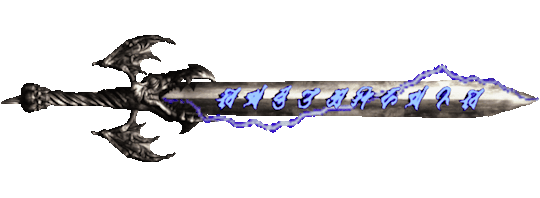
#devil may cry#dmc#original dmc#devil trigger#dt gauge#runes#siddham alphabet#bonji runes#alastor#alastor lightning#gif#my gif#my gif edit#animated gif#sticker#gif sticker
21 notes
·
View notes
Text
Praise be to Yevon
The Yevon script seen in FFX (top image) was inspired by a form of Sanskrit called Siddhaṃ script (bottom image), which is used in one of the oldest and biggest Japanese schools of Buddhism - the Shingon Buddhism.
The letter A of the Yevon script alphabet represents Yevon (you can see this symbol repeatedly throughout the game), while the letter Z represents Sin.
An important practice for Shingon Buddhists is “meditating on the letter A”.
Therefore, this letter has a profound meaning in both scripts.


Info and image source: https://finalfantasy.fandom.com/wiki/Yevon
https://id.m.wikipedia.org/wiki/Aksara_Siddha%E1%B9%83
(phew…I really did miss making these posts for you guys)
#final fantasy x#final fantasy 10#ffx#ff10#square enix#squaresoft#video game#video game trivia#buddhism#yevon#shingon buddhism#sanskrit#siddham script#writing systems#japan#meditation
88 notes
·
View notes
Text
Hey, guys! Want to vote on the best 6th-10th Century script (writing system) that I, Gecko, personally like?
Of course you do! Writing systems are SO COOL!
And here's a bit about each of the contenders:
Arabic (Naskh Script)
Derived from the Aramaic Script, which grew out of Phoenician, Arabic has a variety of forms. The Naskh script is the one I find the most beautiful, with it's extreme variation on character length and height. I also love the use of multiples colours for Ḥarakāt (vowel marks and other diacritics). Add in the elegant curves and solid lines, and Naskh Script becomes one of the most stylish scripts around.

Latin (Insular Script)
Derived from Greek, the Latin alphabet is usually a competent and pleasant mix of lines and curves, uprights and descenders. Insular script plays with these qualities, and the result is electric! many of the uprights (t, d, f) are gone. New descenders are added (r, s, f). Horizontal lines take a new prominence. Line weight is increased, and the curves become more angular. Something old to us becomes new again.

Chinese (Semi-Cursive Script)
There are many ways to write Hanzi (Chinese characters), and Semi-Cursive Script manages to combine the best qualities of most of them! The expressive curves and flow of a cursive script. The solid shapes and readability of Regular Script. One of the joys of Hanzi is the visual interest of so many unique characters; which share components, but use them differently. Semi-Cursive keeps much of that interest, while also providing a dynamic energy and movement.
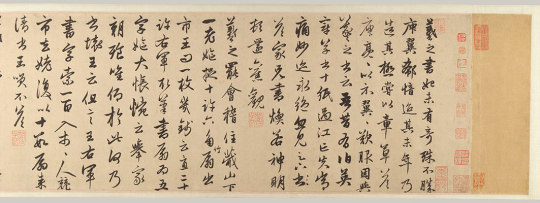
Sogdian (Cursive Script)
Derived from the Syriac script, which grew out of the Aramaic Script, the Sogdian Alphabet was developed by traders who met most of the major cultures of the Old World, and let all of those cultures affect their language and writing. Sogdian can be written write to left, like most Aramaic scripts, but also top to bottom, like the Chinese Scripts of their main trade partner. Curvy cursive lines, and characters of wildly varying length, give this script a interesting sense of flow.

Hebrew (Ktav Ashuri Script with Palestinian Vocalization)
Another offshoot of the (Imperial) Aramaic Script, the Hebrew Alphabet has a really interesting, heavy, square, solid feel. In contrast, Palestinian Voicing (an extinct form of writing vowels where all of them were above the consonants) is really light, stacked on top their vowels in little floaty towers. It's a cool combination!
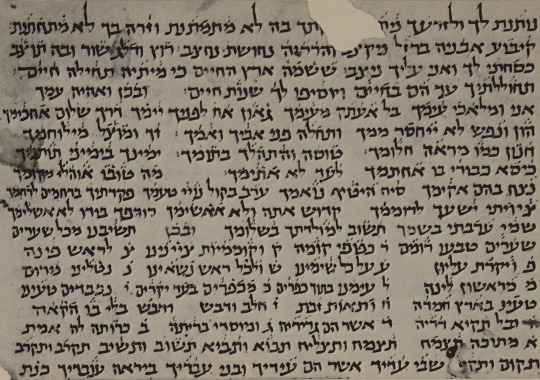
Maya (Classical Maya Script)
The most famous script of the Americas, Maya has one of the most unique reading orders of any script. Characters are written in blocks, which are then read in a zigzag (right, and then down-left) pattern. Full of heads (both animal and human), torches, seeds, and other half-identifiable shapes, Maya texts are works of art, and the more you study them, the more beautiful they become.
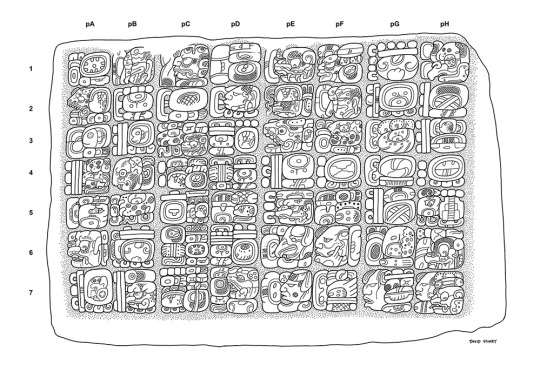
Nubian (Old Nubian Script)
Derived from Greek with additional letters from Coptic (Egyptian) and Meroitic (a previous Nubian culture). Lines above letters are used to skip parts of words deemed unnecessary. The mixture of rectangles and triangles, heavy and light line weights - it reminds me of telegrams, or early typewriter text. I love it!

Khmer (Angkorian Khmer Script)
Derived from the Pallava Script, which derived from the Brahmi Script, Khmer is probably my favourite script to write. The curves feel so good! The spirals so pleasing! You write consonant clusters by writing little letters below the main one! A joy to create, and a joy to look at.

Japanese (Cursive Script)
See these wiggles? They're Chinese characters. Elegant, looking like poetry no matter what they're saying, Cursive Japanese is art. It's also ridiculous. 3 different characters, each with multiple strokes, indicated by wiggling the brush as you draw a line! Most cursive scripts are like this, but the contrast between the square solidness of Regular Script and the flow of Cursive is one of the more extreme. What a delight!

Sanskrit (Siddham Script)
I had SO MANY options for Sanskrit (Brahmi) Scripts, you guys. SO MANY! But in north-west India, during the period I study, this version of Siddham is the prettiest. Look at the curves! Those aren't just decorative, each curvy line that goes above or below the text is a vowel. Consonant clusters are shown by combining the characters together in one spot. The lines at the top haven't yet started connecting, like they do in modern Devanagari, but there's already a sense of it's existence. Such a cool script!
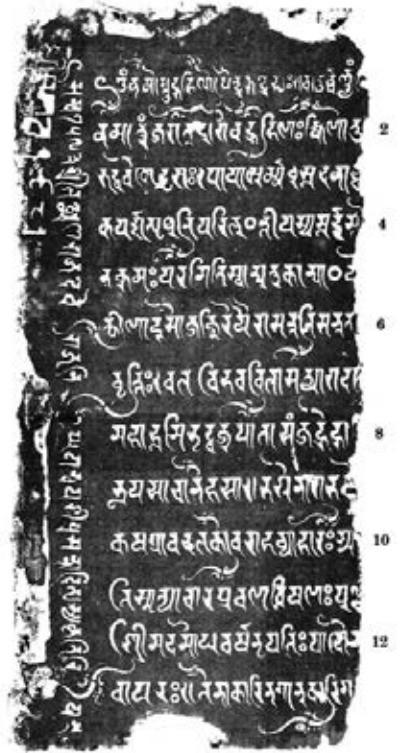
#long post#gecko's polls#calligraphy#scripts#writing systems#arabic#hebrew#khmer#maya#latin#nubian#sanskrit#sogdian#chinese#japanese
227 notes
·
View notes
Text
Cursed Coins (A Disappointment)
@elvesdragonsanddarkmagic was kind enough to send me their meticulous recreations of the cursed coin model, so I had to dick around about 80% less with securing screenshots:


The same set of eight runes repeats on both halves of the coin face, and the same four runes repeat around the length of its edge:
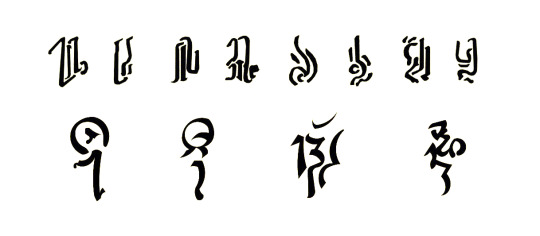
None of these then show up anywhere else. There are a couple in—of all things—Aditi's flashback spell that are just close enough in their general shape and concept that if someone later said, "yeah those are supposed to be the same" I would believe them, and then a couple more that if someone said "the coin face runes correspond to runes from Aditi's spell" I'd tentatively match up. BUT it's really a lot more likely that's just a coincidence:
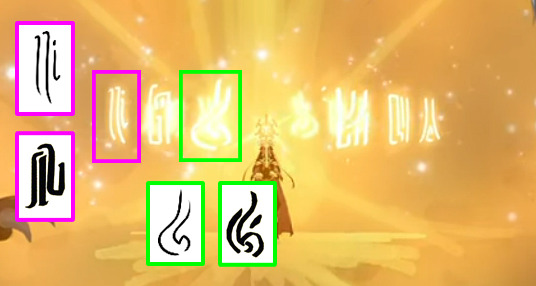
Anyway, since I had nothing better to do I wound up looking at like 30+ different real-world writing systems to see if there were any similarities, the way some of the magic mirror runes are clipped from Devanagari. This was kind of iffy from the start, since the face runes and edge runes honestly look like they come from different writing systems, but whatever. I'm not well-versed in any South/Southeast Asian, Oceanic, or particularly ancient written languages to recognize them on sight, so it wasn't totally wasted effort?
The most similar in "feel," particularly for the edge runes, would probably be something like Siddham, which is an ancestor of Devanagari but still used (pretty much exclusively) in writing Sanskrit texts for Buddhist practices:
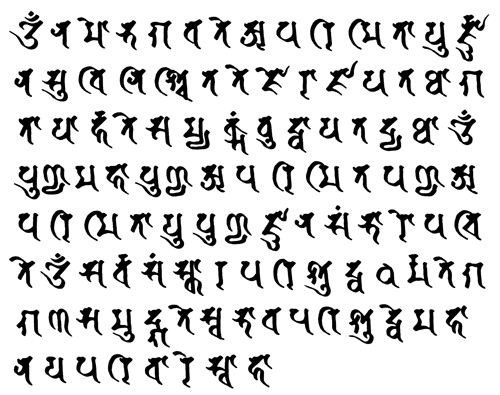
But it can't really be said to be any closer to that than to something like Terran writing from Final Fantasy IX or this one dude's super fancy Latin alphabet styling:
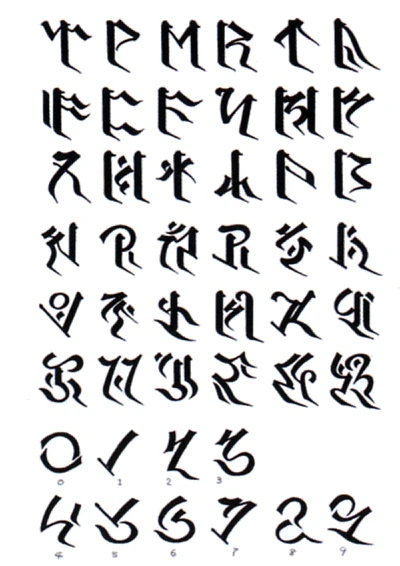
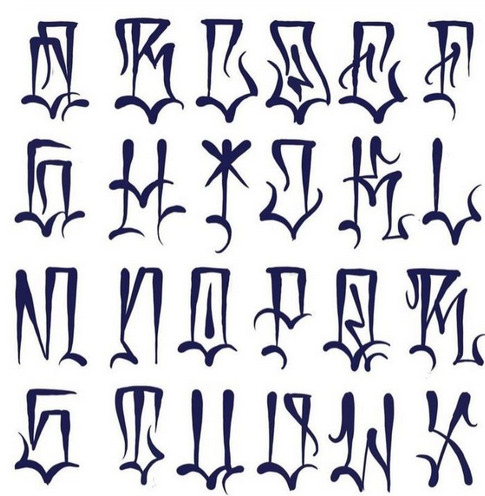
So yeah, at the moment it appears to be just random custom designs, but with some potential of other things matching it in the future.
THIS, though, I'm still 150% certain is going to be a THING:
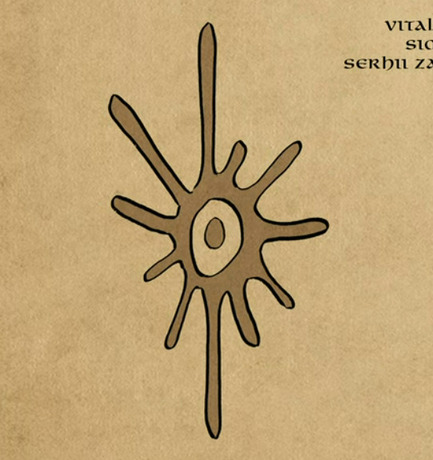
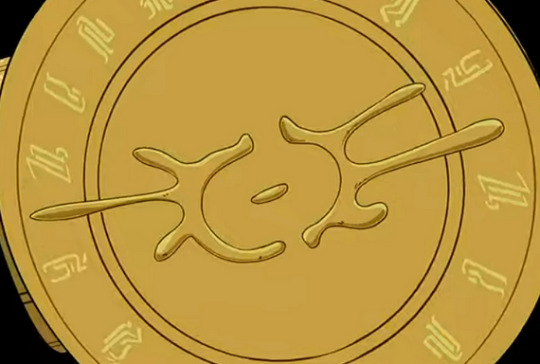
What thing exactly remains to be seen. What would be the significance of a star seemingly split in two? A fallen star broken on impact? Does it represent something else entirely, like a broken wax seal or a splash of liquid or a wide-open eye? IT'S A THING, THOUGH, DAMMIT.
#anyway this was useless but i learned unrelated things so#not a TOTAL waste of a weekend#cursed coin#dark magic#deep magic#meta#analysis#scene comparison
5 notes
·
View notes
Text

The Kyoto Arc Analysis Post (Part 3)
This part covers a look at the magic circles used, more manga geoguessr, and what exactly soul-Haruaki's plan was
Part 1 / Part 2 / Part 3 / Part 4
Magic Circles
A lot of magic circles came up this arc, so this is a good chance as any to look at them.
The one that shows up most frequently is this one Byakko uses.
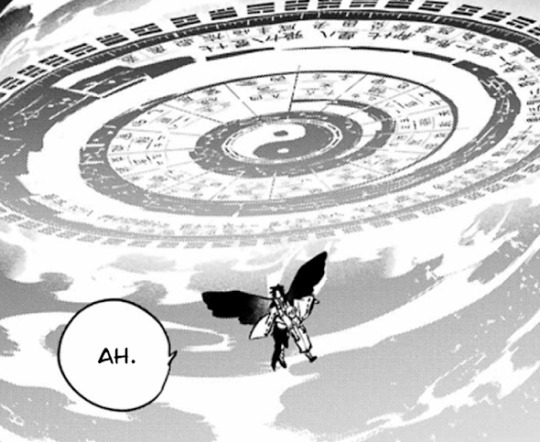

I believe this is based off a luopan, a chinese compass used in fengshui divination. The words match, as well as the compass degree markings in the outer ring.
If it’s an existing asset online, then I haven’t found it, but it’s probably a custom design.
While it doesn’t often have the yin-yang symbol in the center (that’s where the compass goes) there are some designs that do feature it in the center.

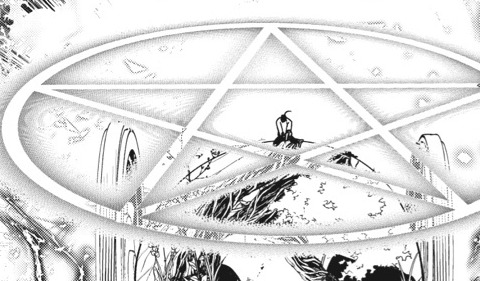
Haruaki has actually had 2 versions of his pentagram, from vol 1 to 8 there was a pentagon inside the circle, and from vol 9 onwards it’s just the star.
However, the star has gotten more detailed this arc! Specifically, you can now see where the lines cross over. (Idk how to explain this just look at it)

(When used by white haired Haruaki. You can also see the principal’s kuji-kiri in his barrier.)

Interestingly, the star doesn’t show up at all when Haruaki was summoning the four gods, instead it’s just the luopan design.
Double interestingly, Seimei has a totally different circle!

(Note the big dipper design in the middle. Or maybe little dipper? The handle is bent the wrong way again! Tanamai sensei do you know the two dippers are different….)
Also, this cloud pattern also shows up on the mark on principal's face.

But when Douman uses it, it’s the star overlaid over the luopan design?? What does this all mean?? Don’t get me started on the rest of that scene. Rest assured that comes later in this essay.

I think this panel in ch 22 is the clearest we get to see Sano’s magic circle. I think the letters are siddham script, used in buddhist scriptures, but I’m not sure what the letters are exactly. This combined with the lotus imagery on the ch 43 cover page means… idk??

There’s also this variant, which is just wacky circles I think.


And then there’s the ones from this arc. (They’re ever so slightly different, I think)
That one in ch 90 actually seems to be the same one as ch 80.5.
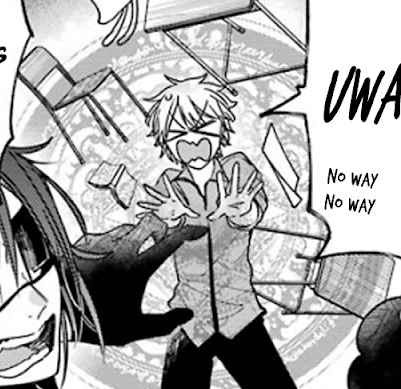
What are the words at the top of this color spread?
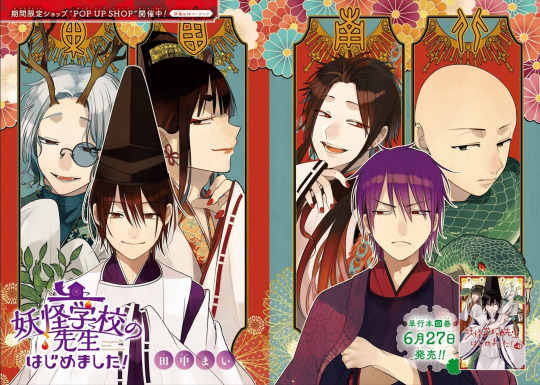
This is a good time as any to talk about this. The characters over the four gods’ are just the directions they represent, in order, east, west, south and north.
Albeit, they don’t look like typical kanji, because these are in fact the chinese pictograph versions of them, which eventually developed into the chinese characters now as well as kanji. Specifically, they’re the jiaguwen versions.
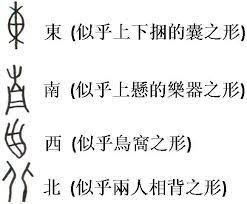
Geoguessr part 2

You see, there was a 3 day gap between the JP raws for ch 90 releasing and the chinese tl to come out, during which time I was bored as hell but also couldn’t do anything else because I was busy refreshing the chinese tl site every 5 seconds.
Clearly, the sane thing to do in this situation is to look at every street near Kinkaku-ji to find where this panel happens.
(Although, this is after I cleaned all the sfx from the JP chapter, but then I had to do it all over again for the CN pages anyway since it’s higher quality and I can’t just paste in the JP blurry raws)
I was originally going to also try to find the previous panel, where Rintarou and Ebisu are hiding under a fan, beside a vending machine, but I couldn’t find where that is.
Anyway, by god did I find this goddamn street.
But you see, dear reader, there’s a twist. This is not one street. This is two sides of the same estate, in other words, the left and right halves of the image are two different streets.
Here’s the link to google maps street view, if this is hard to visualize.
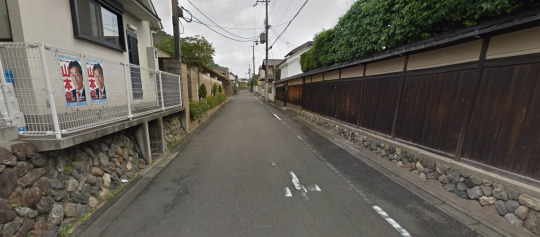

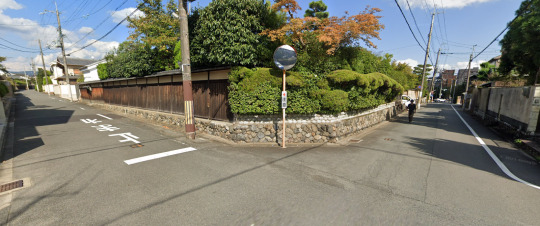
Look at this. What the hell is this. geoguessr impossible difficulty
(Thank god I don’t live in Japan I would have gone there on foot just to check every street)
What Was Soul-Haruaki’s Plan?


If you think about it for one second, his plan doesn’t make a whole lot of sense. Why is he using his power if it doesn’t work on his body? He’s not stupid so what is it?
But if you think about it for two seconds it actually makes sense. Without powers (and even with powers), Haruaki is Just Some Guy. If 1/5 of him starts trying to kill him, what’s he going to do? Run about it? This guy can run just as fast!
The real goal of this maneuver, besides getting Haruaki here, was also to gather the youkai who could possibly help him in one place and knock all of them out. The only reason that didn’t happen was because the principal was there, and Haruaki didn’t know about him before all this anyway.
Also, a translation note/explanation for the term “anti-youkai power”. This is just what the official translation chose to use since the start, since it worked in the moment (and most of the time really). But the japanese word doesn’t actually specifically say it’s “anti” “youkai”. The word is “退魔の力” (taima no chikara), and a more conventional translation is probably “exorcism power” which you may have noticed I use sometimes. The “力 chikara” part is without a doubt “power”, so this is about what “退魔 taima” means. If you were to take the meanings of the two kanji separately, it would be “dispel magic”. The word “魔 ma” is also often used as a prefix for magical beings, so maybe that’s where “anti-youkai” comes from. Anyway, with the “dispel magic” definition, it should be pretty clear why his power works on both youkai and gods, given they’re both magic-based.
Also, as for why this power works on the four gods both times (when Douman stole it from Seimei, and then when soul-Haruaki used it) when it’s never affected Sano very much may be because the four gods bodies are magical constructs summoned into a piece of paper, whereas Sano’s physical body is just here.
(Or maybe also because both soul-aki and Douman were gunning for the kill, and Haruaki is never gunning for the kill ever. could be multiple factors.)
Where is Mount Ooe?

In case you forgot, Mount Ooe has the youkai town where Miki’s family lives. You’d think this is pretty close by, considering it’s repeatedly mentioned that it’s “in Kyoto”, and also Haruaki went there as a kid somehow.
The thing is, (maybe you knew this already and I’m just stupid) Kyoto PREFECTURE is fuckoff massive and Kyoto city is only a tiny tiny part of it.
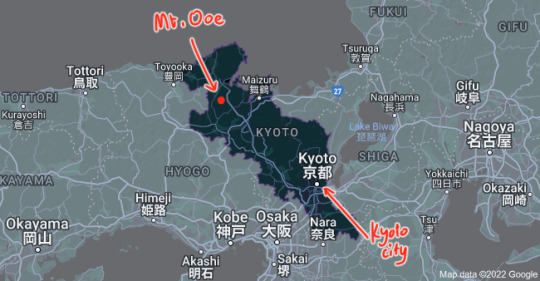
So Mount Ooe is on the other side of Kyoto from where the city is. This is in the mountains, nearly 80km from the city! My new question is what the hell was 10 year old Haruaki doing there??? How did he get there?? Who let him do this?? Mamaaki and Papaaki watch your goddamn son!! Is this what kids in Japan do?? Fuck off 80km into the mountains??
Image limit again, part 4 will be the last! (Finally!)
Part 1 / Part 2 / Part 3 / Part 4
25 notes
·
View notes
Note
thank you for testing my telugu skills w the post tagged as telugublr, i thought i lost my understanding skills because i don't intertact? a whole lot in telugu but good to know i still understand it for the most part
Ala appudappudu prasninchadiniki nenu siddhame
2 notes
·
View notes
Text

Ear Hospital in Jaipur
As the premier Ear Hospital in Jaipur, Siddham Hospital offers painless treatments at affordable prices. Our modern facility ensures comfort and quality care. With skilled specialists and advanced technology, we prioritize your well-being. Experience relief from ear troubles without breaking the bank. Trust Siddham Hospital for expert care tailored to your needs. Your journey to better hearing starts here.
Visit-
0 notes
Text
A Day in Indian Politics: PM Modi's Campaign, Amit Shah's Karnataka Visit, and Jagan's Yatra
Introduction: Today, the Indian political landscape is abuzz with activity as Prime Minister Narendra Modi spearheads his Lok Sabha campaign in Rajasthan and Uttarakhand, while Union Home Minister Amit Shah focuses on bridging gaps in Karnataka with the Janata Dal (Secular). Meanwhile, Andhra Pradesh Chief Minister Y S Jagan Mohan Reddy continues his 'Memanta Siddham' tour amidst rising political tensions. Let's delve into the day's developments shaping the nation's political narrative.

PM Modi's Campaign Trail: Prime Minister Narendra Modi is set to address public rallies in Rajasthan and Uttarakhand today. In Rajasthan, Modi will rally support for the Jaipur Rural Lok Sabha seat, marking his first program in the state since the announcement of polls. Following this, he will head to Uttarakhand to speak at a rally in Rudrapur. These states, where the BJP swept all seats in the last elections, hold significance in the upcoming polls, with Modi's speeches expected to underscore key themes of development, welfare schemes, and Hindutva.
Amit Shah's Karnataka Visit: Union Home Minister Amit Shah embarks on a crucial visit to Karnataka, aiming to resolve any lingering differences with the Janata Dal (Secular), the BJP's alliance partner in the state. Shah's scheduled breakfast meeting with JD(S) leaders signifies a concerted effort to ensure a cohesive approach as the elections draw near. With the BJP contesting on 25 constituencies and the JD(S) on three, the meeting holds significance in strategizing for electoral success.
Jagan's Election Campaign: Meanwhile, Andhra Pradesh Chief Minister Y S Jagan Mohan Reddy presses on with his 'Memanta Siddham' election campaign bus tour. Amidst whispers of anti-incumbency and alliance dynamics, Jagan aims to solidify his grip on the state's political landscape. Continuing his brisk tour, Jagan will address public meetings and traverse various districts, signaling his commitment to retaining power amidst shifting political tides.
Conclusion: As the nation gears up for the Lok Sabha elections, today's political events underscore the fervent campaign efforts and strategic maneuvers shaping India's democratic process. From Modi's rallying cries in Rajasthan and Uttarakhand to Shah's diplomatic initiatives in Karnataka and Jagan's relentless yatra in Andhra Pradesh, each move reflects the dynamic interplay of power and politics. Stay tuned for more updates as the electoral journey unfolds.
0 notes
Photo

100 syllable Vajrasattva mantra
oṃ
vajrasattva samayam anupālaya
vajrasattvatvenopatiṣṭha
dṛḍho me bhava
sutoṣyo me bhava
supoṣyo me bhava
anurakto me bhava
sarva siddhiṃ me prayaccha
sarvakarmasu ca me cittaṃ śreyaḥ kuru
hūṃ
ha ha ha ha hoḥ
bhagavan sarvatathāgatavajra mā me muñca
vajrī bhava mahāsamayasattva
āḥ
oṃ
O Vajrasattva honour the agreement!
Reveal yourself as the vajra-being!
Be steadfast for me!
Be very pleased for me!
Be fully nourishing for me!
Be passionate for me!
Grant me all success and attainment!
And in all actions make my mind more lucid!
hūṃ
ha ha ha ha hoḥ
O Blessed One, vajra of all those in that state, don't abandon me!
O being of the great contract be a vajra-bearer!
āḥ
#vajra#vajrasattva#buddhist#buddhism#bodhisattva#bodhisatva#buddha#mantra#sanskrit#siddham#linguistics
67 notes
·
View notes
Video
youtube
CM YS Jagan’s Memantha Siddham Road Show at Gooty, Anantapur District| M...
0 notes
Text

Siddham Coolers present a tower cooler that delivers powerful airflow with its 3-blade fan and 3-speed motor. Elevate your cooling experience with excellence.
For more information call us on: 63765 10571, 94615 04460
0 notes
Text
The Siddham script, also known as Siddhamātṛkā, is a historical writing system that originated in ancient India. Its name is derived from the Sanskrit word "Siddha," meaning "accomplished" or "perfected," reflecting its association with esoteric knowledge and spiritual practices.
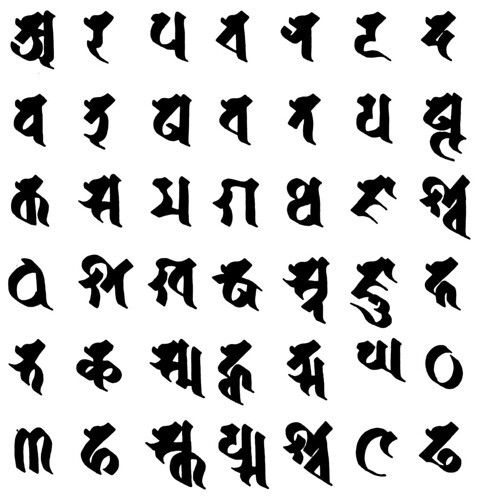
0 notes
Text
Les Civilisations Paléomagos
La découverte pour les humains du monde magique suite à l’Événement de Stonehenge ne fut pas le seul choc majeur qui suivit l’Éveil de la Magie.
Les multiples barrières de dissimulations tombées révélèrent également les Mers, que même les magus avaient oubliés… mais surtout de multiples ruines à travers le monde, prédatant toutes les civilisations connues!
Ces ruines, il s’avéra vite, étaient les vestiges des civilisations Paléomagos, peuples d’Homo Magicus vivant durant le Mésolitique, et ayant disparu au Néolithique.
Ces civilisations faisaient toutes un grand usage de magie, à un niveau équivalent, voire parfois supérieur au niveau de connaissance et de maîtrise de la magie actuel, et même un niveau technique et culturel proche des Homo Sapiens durant l’Antiquité.
De plus, l’usage de magie fait que ces civilisations pouvaient voyager et communiquer à travers le monde avec une facilité qui ne sera plus vue jusqu’à la Révolution Industrielle.
Même si on avait perdu tout souvenir d’elles, ces civilisations avaient clairement laissé leur trace dans l’Histoire, puisqu’on trouve encore, des millénaires après leur disparition, des vestiges de leur culture dans les civilisations humaines ayant suivi.
Liste des Civilisations Paléomagos:
Agartha
localisation : Ouest Asie, principalement dans l’Himalaya jusqu’en Inde et au Népal mais également jusqu’en Mongolie et en Ouzbékistan
langue : Samskrtam Agarthan
écriture : Siddham Agarthan
style architectural : rappelant des temples hindous
Il s’agit d’une civilisation presque entièrement souterraine, si bien que les ruines auxquels on a pu avoir accès sont très bien préservées. En contrepartie, la découverte et l’accès à ces ruines est parmi les plus compliqués.
Les Agarthans étaient un peuple vivant relativement isolé, ne faisant que peu de commerce, et très spirituel, cherchant à se rapprocher toujours plus de l’essence de la magie.
C’est probablement pour cela qu’ils vivaient sous terre, cherchant à se rapprocher plus des points telluriques où la magie était la plus puissante, mais aussi la plus instable.
Leur utilisation de la magie s’appuyait largement sur les gemmes taillées, faisant de leurs zones magiques des œuvres d’art étincelantes.
Avalon
localisation : Europe du Nord-Ouest, de l’Islande à la Bretagne et de l’Irlande jusqu’en Suède
langue : Gaelg Avalonan
écriture : Ogham Avalonan
style architectural : rappelant du celte et viking
Les Avalonans était un peuple très spirituel, mais ouvert aux autres cultures dans son ensemble.
Religieux, la divinité principale de leur panthéon était une déesse de la Magie et de la Flore. Ils construisaient donc énormément en symbiose avec la nature. Leurs ruines ne sont pas faciles à trouver, car les constructions les plus durables sont enfouies pour se rapprocher des lignes telluriques, tandis que le reste était fait pour être difficilement différenciable de la nature.
Des recherches à Stonehenge ont révélé que le site avait été bâti au-dessus d’une place religieuse Avalonane, d’où l’Événement de Stonehenge a probablement été déclenché d’une manière ou d’une autre…
Les écrits à travers le monde semblent s’accorder pour dire que les Avalonans étaient un peuple ayant un don pour la Divination inné.
Atlantis
localisation : Bassin méditerranéen
langue : Ellinika Atlantida
écriture : Alfavito Atlantida
style architectural : rappelant du style gréco-romain antique
Peu de ruines ont pour l’instant été explorés, car cette civilisation possédait probablement les barrières les plus sophistiquées, difficiles à désarmer et dangereuses à forcer. Des rares ruines ouvertes, il est clair qu’ils sont l’influence principale derrière l’architecture gréco-romaine.
Ils paraissaient avoir une approche quasi scientifique de la magie, n’ayant quasiment aucune notion de religion et étaient très commerçants.
Ils ont probablement créé les fondamentaux de l’Arithmancie.
Hyperborea
localisation : de la Suède jusqu’en Corée, couvrant principalement la Russie et l’Europe de l’Est
langue : Hyperboroi Yazik
écriture : Cyril Hyperboreal
style architectural : rappelant les fort militaires XVIIe siècle
C’était un peuple martial, très ordonné, voyant plutôt d’un mauvais œil ceux s’intéressant de trop près aux lignes et points telluriques, car ils étaient considérés comme trop dangereux, puisque la magie environnante en est plus puissante, mais surtout plus instable.
Ils commerçaient assez peu et ont provoqué des conflits avec la plupart de leurs voisins.
Les rares ruines identifiées pour l’instant étaient toutes des forts, massivement fortifiés aussi bien magicalement que physiquement, ayant probablement inspiré les premiers châteaux au Moyen Âge et confirmant leur côté très belliqueux.
Iram
localisation : Moyen-Orient, de la Turquie à l’Éthiopie, de la Libye au Pakistan
langue : Iram-Gi
écriture : Cuneis Irami
style architectural : rappelant Pétra et les villes troglodytes
Tout aussi commerçants que leurs voisins Atlantes, les Iramis avaient en revanche une approche bien plus artistique de la magie, et sont ceux qui ont laissé le plus de recueils écrits de l’époque dans leurs ruines.
En outre, la désertification de la région a enfoui nombre de ruines, les rendant difficiles à retrouver.
C’était un peuple troglodyte, rendant leurs ruines d’autant plus délicates à retrouver, mais le travail fait dans les montagnes et autres ravins où on a retrouvé leurs traces est absolument époustouflant.
Lemurie
localisation : Sub-Sahara et Océan Indien
langue : Al’Lemuria
écriture : Abjad’ Lemuria
style architectural : navires de tous types
On ne sait que peu de choses des Lemures, car très peu de ruines ont été retrouvées.
Cependant, tout indique que c’était un peuple de marins, très doué en astronomie et vivant plus en mer qu’à terre, leurs navires ayant été de vraies villes flottantes.
Malheureusement, cette vie sur l’eau fait que presque tout a été perdu de leur civilisation, à l’exception de quelques restes très dégradés par le temps. Cependant, les rumerus veulent qu’il existe encore certains de leurs navires, si bien protégés qu’ils n’ont pas encore été retrouvés, et que ce seraient eux qui sont à l’origine de la plupart des légendes de navires fantômes.
Mu
Localisation : Amérique du Nord, mais également Nouvelle-Zélande et Australie
langue : Tjukurrpa-Kapi
écriture : Tjukurrpa-Waru
style architectural : rappelant les ruines Incas
Ayant entretenu des liens étroits avec les Avalonans, le peuple de Mu avait une civilisation similaire, mais donnant la part belle à la Faune plutôt qu’à la Flore, et que leurs temples n’étaient pas sous terre mais au cœur des montagnes.
Il est fort probable que les premiers Bestiamihis viennent de cette civilisation.
Tiwanaku
localisation : Amérique du Sud et Centrale
langue : Tsagali Mu
écriture : Sequoyah Mu
style architectural : rappelant les ruines mayas
C’est le seul peuple dont des ruines ont été découvertes avant même l’Événement de Stonehenge, bien que, bien entendu, personne à l’époque n’ait cru à la datation qui paraissait fantaisiste des lieux.
C’est peut-être le peuple le plus différent, cherchant au contraire à s’élever vers les cieux en s’établissant sur de hauts plateaux montagneux plutôt qu’à vivre sous terre comme le faisaient nombre de leurs contemporains.
Ils pratiquaient énormément la magie rituelle, et sont l’exemple typique que l’on donne pour prévenir des dangers de la magie noire : on pense en effet que cette civilisation s’est écroulée avant les autres suite à une pratique trop intensive de rituels dangereux, ayant rendu une bonne partie de leur civilisation folle ou corrompue.
Yamatai
localisation : Japon, Chine et Asie du Sud-Est
langue : Yamatai Guo
écriture : Kan Yamatai
style architectural : rappelant les châteaux japonais
Cette civilisation était probablement la plus isolationniste, n’ayant quasiment pas de liens avec les autres peuples de l’époque et se contentant de commerce interne.
Ils avaient une bonne maîtrise des rituels, et des lois très strictes à ce sujet pour éviter les cas de corruption et de folie.
C’était également un peuple spirituel, respectueux de la magie qu’ils possédaient et tout à fait conscient de sa dangerosité.
Là encore, leur architecture a été adoptée, d’abord part les Youkais, puis par les populations non magiques de la région bien plus tard.
#hippogryphe saoul#jeu de role#H2S lore#ttrpg#les héritiers de l'hippogryphe saoul#H2S#jeu de rôle#jdr#rpg#tabletop rpg#modern fantasy#urban fantasy#fantasy
1 note
·
View note